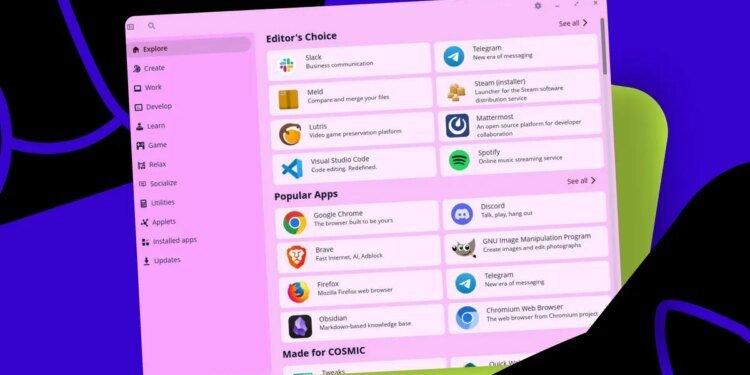
Observe ZDNET: Add us as a preferred source on Google.
ZDNET’s key takeaways
- You do not have to make use of the command line in Linux.
- With the assistance of those free GUIs, Linux turns into a lot simpler.
- These instruments could be simply put in.
Linux is turning into an increasing number of fashionable world wide. A part of the rationale for that’s the finish of Home windows 10. On the identical time, Linux has come a great distance since its early days of solely focusing on builders, admins, or laptop science majors.
This evolution has made it potential to by no means contact the command line (which is one thing that I firmly imagine is feasible).
Additionally: The 4 most Windows-like Linux distros to try because change is hard
For individuals who doubt the veracity of my declare, let me introduce you (and people new to Linux) to GUI apps that take the place of command-line instruments.
All of those apps are free to put in and use.
1. Grsync
When you’ve ever needed to again up your Linux laptop, you’ll have been informed to lookup rsync. Rsync is a command-line sync instrument that’s usually used for backups. Though rsync is pretty easy to make use of, to the uninitiated, it may be a bit daunting. Fortuitously, there’s Grsync, a user-friendly GUI that makes Rsync a lot simpler. That is to not say that Grsync makes rsync simple sufficient for anybody with out having a basic understanding of rsync.
For instance, you want to perceive the distinction between supply vs. vacation spot, permission preserving, and many others. For instance, within the Supply and Vacation spot part of the GUI, you want to know that the supply is what you wish to again up and the vacation spot is the place you wish to home the backup.
You additionally want to grasp the format of distant locations which can be within the SCP format, corresponding to jack@192.168.1.25:/dwelling/jack/Paperwork/. One other factor to remember is that in the event you do not add a trailing /, Grsync will create a sub-document to accommodate the information.
Grsync makes working with rsync a breeze.
Jack Wallen/ZDNET
2. File Supervisor
There are a number of instructions your file manager can care for, corresponding to ls, mkdir, mv, cp, tar, and contact. For instance, you open your file supervisor and it’ll present you the contents of the present listing (ls).
You possibly can right-click a file and choose Copy (cp), drag and drop a file from one location to a different (mv), right-click a file or folder and choose Compress (tar), or create a brand new file by right-clicking an empty area within the file supervisor and deciding on Create File (contact).
The COSMIC File Supervisor may be very consumer pleasant and quick.
Jack Wallen/ZDNET
3. Disks
The Disks app takes over some tougher instructions, corresponding to fsck, mount, parted, chown, and dd. This app is a helpful GUI that additionally prevents you from having to edit the fstab configuration file (for mounting drives at boot), which is a large plus.
Additionally: How to install Arch Linux without losing your mind
Simply keep in mind, the command Disks substitute may be very highly effective, so ensure you know exactly the disk you might be working with; in any other case, you would wind up formatting your main drive housing the OS. Disks is put in on all GNOME-based distributions and several other non-GNOME-based distributions (corresponding to Pop!_OS).
Disks makes working with drives a lot simpler.
Jack Wallen/ZDNET
4. Stacer
Stacer is a good instrument that may assist clear up your OS (rm) and monitor sources (ps). You can too handle startup purposes, seek for information, finish processes (kill and killall), uninstall purposes (apt, yum, pacman, and many others), and handle repositories (nano, add-apt-repository). Stacer has an easy-to-use GUI and a tab for every function. This needs to be thought-about a must-use for anybody critical about dumping the command line.
I do want Stacer had a lightweight theme, or would observe system themes.
Jack Wallen/ZDNET
5. Meld
When you’ve ever needed to evaluate the contents of two information, you’ve got most likely used diff, which is not precisely essentially the most user-friendly command present in Linux. Fortunately, there are instruments like Meld that assist make evaluating information a lot simpler. Meld also can merge information. Needless to say Meld does not work with binary information (corresponding to .odt or .docx), so you may must convert such paperwork into .txt format.
Utilizing this GUI is way simpler than the diff command.
Jack Wallen/ZDNET
6. Edit, Kate, or COSMIC Textual content
Sooner or later, you are going to want a fundamental textual content editor. The reason being that you simply won’t wish to need to edit a configuration file or different textual content file inside the nano, vi, or emacs editors. As an alternative, use the likes of GNOME Edit, Kate, or COSMIC Textual content. The one caveat to utilizing fundamental textual content editors is that you simply might need bother modifying configuration information that require sudo (or root) privileges. Every of those apps affords completely different options, however all of them get the job of making and modifying flat textual content information executed.
COSMIC Textual content is without doubt one of the quickest textual content editors I’ve used.
Jack Wallen/ZDNET
7. GNOME Software program/KDE Uncover/COSMIC Store
When you hate the thought of utilizing the apt, dnf, pacman, zypper, snap, or flatpak instructions to put in software program, you possibly can all the time flip to your distribution’s GUI entrance finish, corresponding to GNOME Software program, KDE Uncover, or COSMIC Store. There’s additionally the old-school Synapitic GUI, however I might suggest one of many different three first.
Additionally: This Linux distro I recommend to power users takes a unique approach to OS design
Needless to say GNOME Software program is for GNOME and GNOME-based desktop environments, KDE Uncover is for KDE Plasma, and COSMIC Store is for the brand new COSMIC desktop atmosphere. Though many discover putting in from the command line simple, many would somewhat go along with a point-and-click GUI, somewhat than memorize all of these instructions (and their choices).
COSMIC Retailer is a lot sooner than the earlier COSMIC Store app.
Jack Wallen/ZDNET
8. PuTTY
Lastly, there’s PuTTY, which takes care of the ssh command. The PuTTY GUI would possibly look a bit outdated, however it’s nonetheless highly effective and helpful. The most effective issues about PuTTY is that it permits you to save hosts, so connecting to a distant machine is only a matter of choosing the host in query. PuTTY does have a slight studying curve, however for individuals who are new to Linux, it is nonetheless simpler than utilizing the command line.
The PuTTY GUI might use some consideration.
Jack Wallen/ZDNET
Need to observe my work? Add ZDNET as a trusted source on Google.



